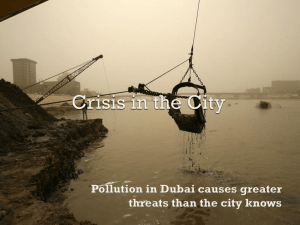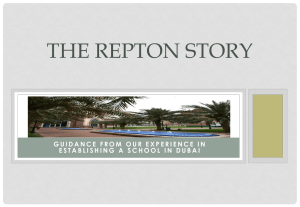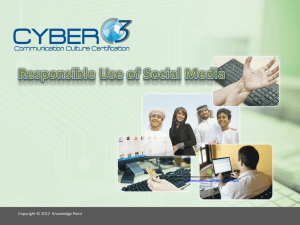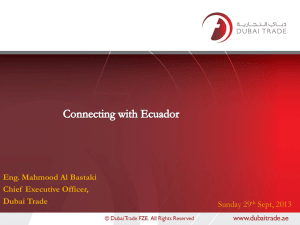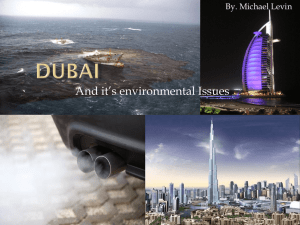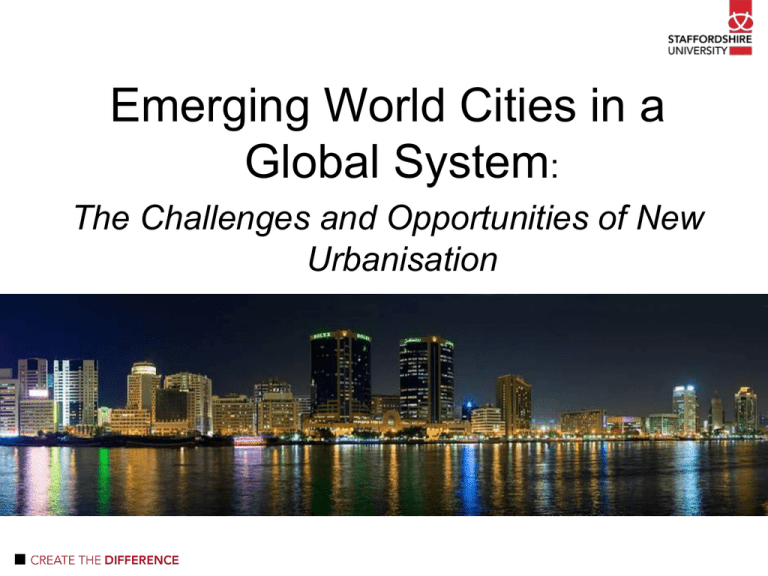
Emerging World Cities in a
Global System:
The Challenges and Opportunities of New
Urbanisation
The presentation
• A new way of thinking about Geography
• Globalisation and the ‘world city network’
• Emerging world cities – Pacific Asia and
beyond
• ‘New’ urbanisation’: a case study of Dubai
Globalisation
• Time-space compression has transformed
the structure and scale of human
relationships - social, cultural, political and
economic processes now operate globally.
• It is argued that we live in a borderless
world in which the nation-state has been
rendered impotent by ‘footloose’ MNCs
which do not respect ‘national’ boundaries.
• The death of Geography and difference?
Uneven globalisation – 3 ‘key arenas’
The world city network
• Globalisation actually enhances the role of
cities. Cities are nodes through which
global systems of capital production and
exchange are organised (e.g. MNC HQs).
• All cities operate in a global system.
• A global perspective reveals how a city
cannot just be studied in isolation but has
to be understood as belonging to a
network of cities that stretches across the
world.
Cities exist within a complex web of
connections
The world city network
• The Globalisation and World Cities
(GaWC) network - a network of researchers
who have attempted to measure how
connected cities are to each other.
• Cities are more less integrated into the
global system – arguably those that are
more integrated are more successful.
• This is dynamic and constantly changing!
Most connected cities
1
2000
London
100.00
1
2008
New York
100.00
2
New York
97.10
2
London
98.64
3
Hong Kong
73.08
3
Hong Kong
81.33
4
Tokyo
70.64
4
Paris
77.91
5
Paris
69.72
5
Singapore
74.15
6
Singapore
66.61
6
Tokyo
72.58
7
Chicago
61.18
7
Sydney
71.76
8
Milan
60.44
8
Milan
70.05
9
Madrid
59.23
9
Shanghai
68.77
58.75
10
Beijing
67.67
10 Los Angeles
Most connected cities
1
2000
London
100.00
1
2008
New York
100.00
2
New York
97.10
2
London
98.64
3
Hong Kong
73.08
3
Hong Kong
81.33
4
Tokyo
70.64
4
Paris
77.91
5
Paris
69.72
5
Singapore
74.15
6
Singapore
66.61
6
Tokyo
72.58
7
Chicago
61.18
7
Sydney
71.76
8
Milan
60.44
8
Milan
70.05
9
Madrid
59.23
9
Shanghai
68.77
58.75
10
Beijing
67.67
10 Los Angeles
The rise of Pacific Asia
• Hong-Kong (3rd) – the economic Gateway
to China, supported and challenged by
Shanghai (9th) and Beijing (10th).
• Singapore (5th), Tokyo (6th), Sydney (7th)
Emerging world cities
• Outside of the three ‘key arenas’ of
globalisation, key cities in ‘developing’
countries are important economic gateways.
• Buenos Aires (16th), Mumbai (17th), Sao
Paulo (21st), Mexico City (24th), Caracas
(38th), Santiago (41st), Johannesburg (44th)
A case study of Dubai
• The Middle East is an emerging arena of
globalisation – and its cities are emerging
world cities, becoming increasingly
connected into the world city network.
• Dubai is emerging as the key economic
gateway to the Middle East (52nd).
• Other emerging world cities in the region
include Riyadh (59th), Cairo (61st) and
Kuwait City (65th).
A case study of Dubai
• Up to 1956, when the first concrete
building was constructed, the entire
population lived in ‘basrasrti’ homes made
from palm fronds.
• Dubai’s chief regional advantage has been
its endowment of offshore oil – although
this is modest compared to Abu Dhabi and
other Middle Eastern states.
A case study of Dubai
How might we describe the type of city being
created in Dubai?
• “Dubai is a prototype of the new postglobal city, which creates appetites rather
than solves problems”
• Dubai has become the new global icon of
‘imagineered urbanism’ – “…an emerging
dream world of conspicuous consumption
and what the locals boast as ‘supreme
lifestyles’”. Davis (2006)
A case study of Dubai
‘Apocalyptic luxuries’ (Davis 2006)
• Dubai is a city of extreme luxuries based
on the wealth derived from offshore oil –
i.e. they are gained at the expense of
massive environmental damage.
• In a utopian model, this windfall would
become an investment fund for raising the
environmental efficiency of urban
systems. In the real world of capitalism,
this has not happened.
A case study of Dubai
An economically sustainable strategy for
development?
• In short, no. For a start, Dubai’s modest
offshore oil resources are now rapidly
being exhausted.
• Dubai’s economy is in ‘speculative
overdrive’ - global excess profits from the
hugely inflated price of oil exports is
invested in real estate markets and the
construction of huge skyscrapers.
A case study of Dubai
“If past business cycles are any guide, the
end could be nigh and very messy”
Davis (2006)
A case study of Dubai
What are the challenges and opportunities
facing Dubai in a post-oil economy?
• Assuming that the ‘mega-project
blitzkrieg’ would run as planned, it was
predicted that Dubai would derive all its
GDP from non-oil related activities like
tourism and finance by 2010.
• Dubai predicted that the city would
attract15 million overseas visitors a year
by 2010.
A case study of Dubai
• Dubai also aims to become a leading hub
in the global economy, and position itself
as a hub for institutional finance and a
gateway to the Middle Eastern region for
capital and investment.
• The Dubai International Financial
Centre (DIFC) is expected to rival
international financial centres in New
York, London, Singapore, Hong Kong,
and Tokyo.
A case study of Dubai
However, there are some key conflicts
here with Arab Muslim culture:
• Prostitution and a sinister sex trade built
on kidnapping, slavery and violence –
while the regime disavow any collusion
with this industry, insiders know that this
trade is “essential to keeping the 5-star
hotels full of European and Arab
businessmen” Davis (2006).
A case study of Dubai
• The education of women is essential if
Dubai & the UAE are to modernize their
economy & become the high-tech hub of
the Middle East.
• Will a society based on traditional values
let women become truly become equal
partners in business and society?
A case study of Dubai
• Islamic finance is based on Islamic
religious grounds. It prohibits three aspects
of conventional interest-based economics:
riba (interest), gharar (uncertainty), and
maysir (gambling). How will this effect the
development of Dubai as an emerging
global financial centre?
• The disappearance of traditional culture and
sense of history pride have begun to
disappear into Westernised popular culture.
A case study of Dubai
‘Forced labour’ and migrant exploitation.
“Dubai’s luxury lifestyles are attended by
vast numbers of Filipina, Sri Lankan and
Indian maids, while the building boom is
carried on the shoulders of an army of
poorly paid Pakistanis and Indians…
working twelve-hour shifts, six and a half
days a week, in the asphalt-melting desert
heat” Davis (2006)
A case study of Dubai
• 99% of the private sector workforce are
immediately deportable non-citizens –
from South Asia, Pakistan, India,
Bangladesh and Sri Lanka
• Dubai flouts international labour
regulations and refuses to adopt the
international Migrant Workers Convention.
• Rights disappear as often recruitment
agencies confiscate passports and visas
when immigrants arrive.
A case study of Dubai
• The construction industry has an appalling
safety record and neglects even the most
basic needs of its workers.
• In 2004, Human Rights watch estimated
that as many as 880 construction workers
were killed on the job, with most fatal
accidents going unreported.
A case study of Dubai
• Press Freedom is restrained from
reporting on exploitive working conditions
and prostitution.
• Workers are crowded into work camps on
the city’s outskirts, up to 12 to a room,
often without air conditioning and
functioning toilets. Conditions are squalid
and often unbearable.
A case study of Dubai
• Migrant workers are paid very low wages
($100 to $150 per month) for working up
to 20 hours per day. Often this pay is
withheld for many months.
• Much of this will be sent home, often
leaving these workers with no money at
all.
• Workers complaining to authorities are
threatened with deportation.
A case study of Dubai
“This existence weighs heavily on
Adnan… he feels trapped… We listen
quietly as he narrates his story… His state
of mind is expressed in the statement
“jism chall raha hain magar rooh ne sath
chodh diya hai” (the body is still going but
the soul has departed). Every so often he
has to stop as his eyes begin to well up
with tears which must not be allowed to
fall and undermine his masculinity”.
A case study of Dubai
Very rarely do we see truly ‘new’ urbanisation.
Dubai is an emerging world city being built
from scratch… but is its construction a story
of missed opportunities?
• Environmental sustainability
• Economic sustainability – a ‘third’way?
• Racial and sexual equality
• Cultural diversity and tolerance
• Social justice, welfare and human rights
Take a look at…
The Globalisation and World Cities
website: http://www.lboro.ac.uk/gawc/
Global Urban Analysis: A survey of cities in
Globalisation (Earthscan, 2010)
Davis, M (2006) “Fear and money in Dubai”
New Left Review volume 41, pp 47-68
Geography at Staffordshire
University
Interested in studying at a department rated
8th in the country?
Contact:
Allan Watson, Admissions Tutor
a.watson@staffs.ac.uk


